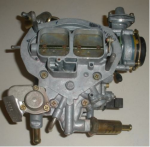rab
Well-Known Member
- Joined
- Aug 16, 2009
- Messages
- 289
- Vehicle Year
- 87
- Transmission
- Manual
Alright, I bought an '83 ranger 2.0 4 speed, the motor was junk, I pulled a 2.3 from my buddies '78 fairmont to swap into the ranger.
I have deleted the emissions stuff as well. I have a few questions regarding the ports/vacuum lines on the carburetor.
It has the stock '78 5200 2bbl carb, does anyone have a diagram of all the ports on it, i.e. what each port is for?
My two main questions are, where does the vacuum advance from the dizzy get routed to?
What is this port for (the bigger one in the bottom left of this pic)?
I have deleted the emissions stuff as well. I have a few questions regarding the ports/vacuum lines on the carburetor.
It has the stock '78 5200 2bbl carb, does anyone have a diagram of all the ports on it, i.e. what each port is for?
My two main questions are, where does the vacuum advance from the dizzy get routed to?
What is this port for (the bigger one in the bottom left of this pic)?
Attachments
Last edited:













